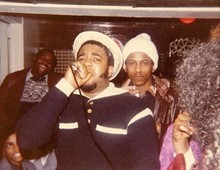
The Geopolitical Factors Crucial in Fostering Rap's Early Development
Bill Adler, hip-hop music critic, observed:
In New York City in the mid-70s, the dominant Black popular music was disco, as it was every place else. The difference about New York was that kids were funk fiends who weren't getting their vitamins from disco music. It was "too nervous," in their terminology, which meant too fast. It was too gay. It was something, but it just didn't move them, and so they were thrown back into their own resources, and what happened was that they started to … play a lot of James Brown. … His old records were staples, and Kool and the Gang, and heavy funk like that developed. I mean, part of it just had to do with there being a lot neighborhood parks in New York City … and what kind of music was played in those parks by the disc jockeys there.
(Adler in Keyes 2002, 44)
The over-commercialization of disco undoubtedly helped the development of hip-hop culture, dance, and music. However, other geopolitical factors were also crucial in fostering its early development: the disruption of rent-control communities in the Bronx as a result of the construction of the Cross Bronx Expressway; post-industrial conditions (such as the replacement of industrial factors with information service corporations); and, eventually, the dwindling of funds from inner-city or public arts programs. By the 1970s, federal monies allocated to inner-city infrastructure were being redirected to build suburban areas. In the phenomenon known as "white flight," Whites fled areas like the Bronx for the suburbs, leaving behind an increasingly neglected inner-city inhabited by the poor Black and Latino working-class.
Crime increased as conditions worsened in the Bronx. First, youths formed street gangs to protect their neighborhoods from outsiders, but eventually, protection gave way to gang territorial or turf wars. Statistics reveal that in 1973 New York City had 315 gangs with over 19,000 members (George 1992, 11). As gang violence eventually made its way into the neighborhood clubs, local DJs decided to use their music as a way of controlling the crowd. They took the music out of the clubs and into the streets, setting up large sound systems in outdoor contexts such as parks and block parties.

DJ Hollywood
DJs such as DJ Hollywood (often regarded as the first person to incorporate rhythm and rhyme poetic phrases over a danceable beat), DJ Flowers in Brooklyn, and Pete "With the Funky Beat DJ" Jones in Harlem garnered prestigious reputations in their immediate areas, not only for their ability to establish social cohesiveness among their local audiences but also for their extraordinary skills in spinning funk dance music on the turntables. Many of these DJs also traveled from borough to borough or location to location, becoming well known as street or itinerant DJs, who were judged not only by their repertoire but by the size of their sound systems, which enabled people to hear them over considerable distances.






